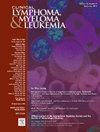外周血单倍体干细胞移植后使用环磷酰胺和早期免疫抑制的结果。
IF 2.7
4区 医学
Q2 HEMATOLOGY
引用次数: 0
摘要
外周血(PB)移植越来越多地应用于移植后环磷酰胺(PT-Cy)的单倍同型造血干细胞移植(haploi - hsct)。钙调磷酸酶抑制剂(CNI)和霉酚酸酯(MMF)在PB单倍hsct中启动免疫抑制(IS)的最佳时机尚不清楚。本研究评估了在PT-Cy之前早期开始IS治疗的结果。方法:回顾性分析2017年至2022年接受PB单倍造血干细胞移植合并PT-Cy的成年血液恶性肿瘤患者的医疗记录。在输注后第0天和第1天开始使用含CNI和MMF的IS。使用Kaplan-Meier方法对生存结果进行统计分析,并使用累积发生率(CI)模型来解释复发和非复发死亡率(NRM)的竞争风险。结果:共纳入51例患者,中位年龄37岁(范围19-63),中位随访时间44个月(范围37.8-53个月)。中性粒细胞和血小板分别在98%和96%的患者中植入。CRS发生在35.3%的患者中,主要是I级,只有1例患者发生II级CRS。3年时,总生存期(OS)和无进展生存期(PFS)分别为51.8%和50.2%,gvhd无复发生存期(GFRS)为43.1%。3年复发率CI为28.2%,NRM为21.6%。结论:在PB单倍hsct中,早期开始IS与高移植率、低CRS率和良好的长期生存结果相关。需要前瞻性研究来验证这些发现并完善IS的时机。本文章由计算机程序翻译,如有差异,请以英文原文为准。
Outcomes of Peripheral Blood Haploidentical Stem Cell Transplantation With Post-Transplant Cyclophosphamide and Earlier Initiation of Immunosuppression
Introduction
Peripheral blood (PB) grafts are increasingly used in haploidentical hematopoietic stem cell transplantation (haplo-HSCT) with post-transplant cyclophosphamide (PT-Cy). The optimal timing for initiation of immunosuppression (IS) with calcineurin inhibitors (CNI) and mycophenolate mofetil (MMF) in PB haplo-HSCT is unclear. This study evaluates the outcomes of early initiation of IS prior to PT-Cy.
Methods
Medical records of adult patients with hematologic malignancies who received PB haplo-HSCT with PT-Cy between 2017 and 2022 were retrospectively reviewed. IS with CNI and MMF were started on day 0 and 1 postinfusion. Statistical analyses for survival outcomes were performed using the Kaplan–Meier method, and cumulative incidence (CI) models were used to account for competing risks for relapse, and nonrelapse mortality (NRM).
Results
A total of 51 patients were included, with a median age of 37 years (range: 19-63) and a median follow-up of 44 months (range: 37.8-53 months). Neutrophil and platelet engraftment were achieved in 98% and 96% of patients, respectively. CRS occurred in 35.3% of patients, predominantly grade I, with only 1 patient developing grade II CRS. At 3 years, overall survival (OS) and progression free survival (PFS) were 51.8% and 50.2%, respectively, and GVHD-relapse free survival (GFRS) was 43.1%. The CI of relapse and NRM at 3 years were 28.2% and 21.6%, respectively.
Conclusion
Early initiation of IS in PB haplo-HSCT was associated with high rates of engraftment, low rates of CRS, and favorable long-term survival outcomes. Prospective studies are needed to validate these findings and refine IS timing.
求助全文
通过发布文献求助,成功后即可免费获取论文全文。
去求助
来源期刊

Clinical Lymphoma, Myeloma & Leukemia
ONCOLOGY-HEMATOLOGY
CiteScore
2.70
自引率
3.70%
发文量
1606
审稿时长
26 days
期刊介绍:
Clinical Lymphoma, Myeloma & Leukemia is a peer-reviewed monthly journal that publishes original articles describing various aspects of clinical and translational research of lymphoma, myeloma and leukemia. Clinical Lymphoma, Myeloma & Leukemia is devoted to articles on detection, diagnosis, prevention, and treatment of lymphoma, myeloma, leukemia and related disorders including macroglobulinemia, amyloidosis, and plasma-cell dyscrasias. The main emphasis is on recent scientific developments in all areas related to lymphoma, myeloma and leukemia. Specific areas of interest include clinical research and mechanistic approaches; drug sensitivity and resistance; gene and antisense therapy; pathology, markers, and prognostic indicators; chemoprevention strategies; multimodality therapy; and integration of various approaches.
 求助内容:
求助内容: 应助结果提醒方式:
应助结果提醒方式:


